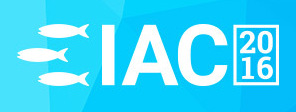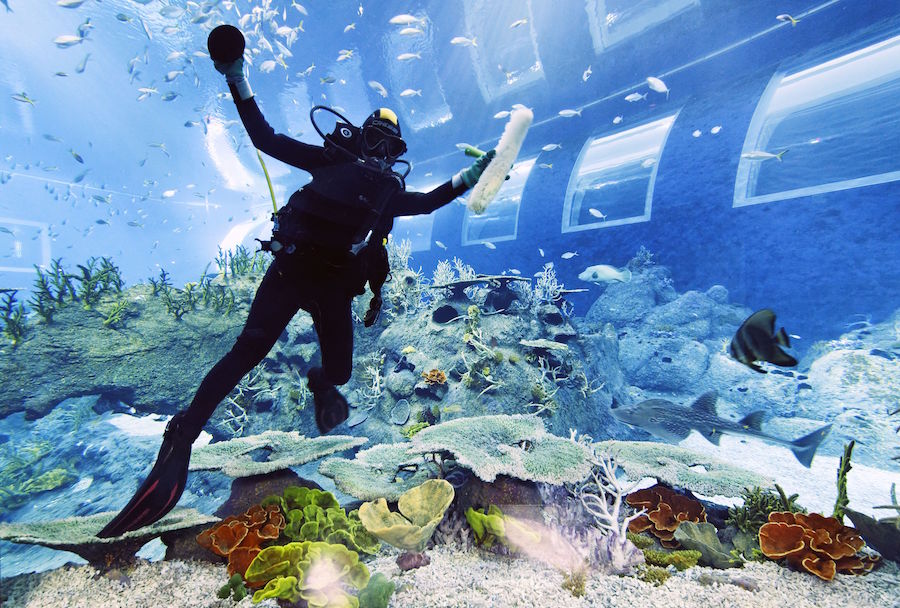The world renowned Vancouver Aquarium hosted the 2016 International Aquarium Congress (IAC). It was also the aquarium’s 60th anniversary.
The conference is the major event for professionals working in the public aquarium sector. Held every four years, it brought together more than 500 delegates from over 120 countries. It was held September 26th to 29th.
countries. It was held September 26th to 29th.
Sponsors for the conference included zoo and aquarium design firm The ZoOceanarium Group and theming construction firm Cost of Wisconsin.

Aquariums, a Force for Change
The International Aquarium Congress was packed with speakers from the world’s leading aquariums. They highlighted the vital conservation work aquariums do. However, there were also a number of keynotes designed to look at the broader issues affecting the marine environment.
The night before the congress, Vancouver Aquarium held the opening reception. It was well attended and gave delegates a good introduction to both the local marine life and the aquarium’s conservation work. Despite being a ticketed event, at least one local tried to crash the party (below).

Grow the Choir
The four day conference was introduced by Dr. John Nightingale, CEO of Vancouver Aquarium. He first of all welcomed delegates to the city of Vancouver on behalf of the aquarium, which proved throughout the week to be a warm and generous host.
He then emphasized the importance of the global aquarium community and the role it plays in educating a public that is, at times, ”tired of bad news”. Education about the many threats facing our marine environment is of course vitally important, but should include a good emphasis on the solutions as opposed to just highlighting the problems.
With this message in mind he said that, though the aquatic environment faces many challenges, “The thread running through the conference is positive”. Aquariums should be a “force for change” and help “grow the choir”.

The Key Role of Public Aquariums
The keynotes were in turns fascinating, bleak, enthralling and inspiring.
Two sessions, from John Englander and Dr Gregry Flato looked at the impact of man-made climate change on the environment. Englander told delegates how climate change is making the sea warmer and changing its acidity. It is also adding vast amounts of fresh meltwater to the oceans, thus raising sea level and altering ocean currents. He suggested that the problem is so deep that our only hope is to slow down and attempt to mitigate its effects.
The key was education and public aquariums, with over half a billion visitors a year, can play a vital role. He showed a video of him in the Arctic watching glaciers breaking off into the sea. “If you entertain any idea of stopping an iceberg”, he said’, “you’ve never seen one”.
Dr. Flato delivered a remarkable keynote on the second day. Looking at climate change models and projections, he ran through the evidence with a series of powerful graphs and charts, each illustrating the alarming and indisputable nature of the challenge facing us. His presentation was understated, authoritative and riveting.

Tinkering with Ecology
Other keynotes looked more specifically at the challenges facing both marine and freshwater ecosystems.
Dr. Paul V. Loiselle, Emeritus Curator of Freshwater Fishes at the New York Aquarium spoke eloquently about the challenges facing freshwater fish. With free-standing fresh waters making up ony 0.5% of the earth’s water, they are home to 40% of the approximately 33, 000 identified fish species. The huge pressures placed upon these often small and isolated communities are causing many extinctions to the extent that some species now only survive thanks to the dedication of the hobbyist community.
Dr. Loiselle advised public aquaria to work more closely with hobbyists as the latter provide a huge reservoir of experience and successful husbandry to tap into and work with. He said that more species, rapidly disappearing in the wild, should be captive bred and the species safe guarded by public aquariums.
We were, said Dr. Loiselle, “tinkering with ecology on a Faustian scale” and cautioned that “If you take apart a clock, it is a good idea to have a box in which to put the pieces”.
Coral Reefs Showing Resilience

Another fascinating keynote at the International Aquarium Congress was from Dr. James Guest. He looked at the health of the world’s coral reefs, and cited “Reasons for Both Optimism and Despair”.
An academic and researcher, his work focuses mainly on reefs in Southeast Asia and Micronesia. He studies the environmental and ecological processes that impact the persistence and potential recovery of reef communities, especially in heavily impacted environments. He is also a science advisor to coral reef conservation charity, SECORE International.
In a fascinating review of the world’s reefs, he discussed the Caribbean (“the poster child for degradation of reefs”) and The Great Barrier Reef. He also highlighted the seemingly disturbed reefs of Singapore, which are showing a remarkable and unexpected resilience.
Dr. Guest also touched on the idea of “assisted evolution”. He wondered if corals showing thermal tolerance were perhaps losing out in other areas (“a trade off?”). He managed to successfully deliver a sobering, scientific analysis of an undoubtedly grave situation, but also inject a note of cautious optimism. A tough trick.
Husbandry and Business
The days were organised with keynotes in the early morning then from late mornings onwards there were two sessions running concurrently. These were more specific and focussed on either the animals or the business operations of aquariums. Subjects covered in the former included Elasmobranch husbandry, marine mammal and turtle conservation, and aquatic diseases.
Broader business and conservation issues were addressed in the other sessions. These included temporary exhibits, new aquariums being built, coral conservation, life support systems, education, public outreach and field conservation.

As the International Aquarium Congress had over 95(!) presentations, it was not possible to catch them all, but highlights included:
Coral, Collection, Breeding and Trust Work
Jamie Craggs, Aquarium Curator at London’s Horniman Museum and Gardens spoke about Project Coral. He is the founder of this pioneering multi-year research project, the aim of which is to investigate the impact of climate change on corals. It has a particular focus on their tolerance to the changing chemistry of the ocean and how this impacts upon coral resilience and ability to reproduce.

Lyle Squire, CEO and Director of Queensland-based Cairns Marine gave delegates an insight into the practicalities of sourcing animals on the reef in Australia. His talk was entitled, “Sustainable Collections from Pristine Reefs”.
The territory is vast. Lyle used Google Maps to good effect, showing just how infinitesimally small the area from which the company sources its corals is. The health of the entire reef system is the key concern not the less-than-minimal impact of the collection of stock from the reef.
The Queensland Coral Fishery has a total quota of 200 tons of coral a year. This comprises 60 tons of live coral and the remainder is live rock and Acropora coral. It represents around 0.00004% of the reef’s annual regrowth.
Paul Cox is Managing Director of the conservation body, The Shark Trust. He ran through the issues effecting sharks and talked about The Trust’s vital conservation work.
Plastic not Fantastic
Rob Hicks, is Displays Development Director at Merlin Entertainments Group. At Merlin for over 20 years, he has been instrumental in the growth of the company’s Sea Life brand. With over 50 facilities across the world, Sea Life is in a strong positon to lead the way in terms of marine conservation. Merlin and Sea Life support the Sea Life Trust,  a registered charity that aims to protect the ocean environment.
a registered charity that aims to protect the ocean environment.
Rob’s session at the International Aquarium Congress looked at how Sea Life works with Grey Nurse Sharks (Charchaias Taurus). He then discussed their successful management in captivity.
Dr. Peter Ross of The Vancouver Aquarium Marine Science Centre spoke about ocean pollution and ocean plastics. He detailed the recent history of ocean pollution and outlined some notable success stories. A toxologist, Dr. Ross studies marine mammals as they are the “perfect canaries in the coal mine”. He then focused on plastics. With each of us being responsible for our own weight in plastic per year, the problem of plastic pollution is huge. Identifying exactly which chemicals to hone in on, is in itself “a black art”.
Julie Packard’s closing Keynote
The final keynote of the International Aquarium Congress was from Julie Packard. Julie is the CEO and co-founder of Monterey Bay Aquarium.
She delivered a briliant, inspirational presentation. Talking about how aquariums should engage with the public, she suggested they should, “be local, be engaging & know your audience”. With wonderful, astonishing exhibits, they should “be a portal for cool stuff!”
However, Packard also counselled that one of the biggest challenges is learning about the aquarium’s guests. “What the visitors think? We know more about what is going on in the tanks than outside them.
“We need to nurture actions that make a difference, like seafood. And then grow them up into movements.”
Packard acknowledged that “people love cute furry things”. As a scientist, she said, this could be frustrating. In spite of this, she pointed out that this propensity could nevertheless be leveraged. Learning about the visitors was key to education and to helping aquariums in thier conservation initiatives. “Forget what we want people to know, what do THEY want to know!
On a final note, Packard tied together the threads running through the conference. She didn’t underestimate the challenge faced by the aquarium community, and she didn’t downplay the serious nature of the impact of man-made climate change. She said, however, that she was an optimist.
“People are the problem but also the solution. There are so many great things happening around the world. Our responsibility is to create a positive future.”
The10th International Aquarium Congress: introducing Fukushima
The next and tenth International Aquarium Congress will be at Aquamarine Fukushima in Japan. It will be held in early November 2018 with a working title of, “Think about Our Future on the Water Planet”.

In conclusion, Director Yoshitaka Abe and his colleagues gave a colourful, flag-waving finale to the conference. They extended a warm invitation to delegates to visit Japan for the conference. If their kind invitation lost a little in translation, (“Fukushima radiation levels are down to almost the same as other cities like LA. There’s nothing to worry about”) it was nonetheless heartfelt.
As the International Aquarium Congress 2016 ended and the assembled aquarists, marine biologists and aquarium exectuves headed home, they could reflect on a successful week. With the wonderful hospitality of the Vancouver Aquarium, a conference packed with eye-opening, fascinating presentations and the glorious city of Vancouver providing a stunning backdrop it was a week to remember. Onwards to Fukushima.
Image credits: main image, turtle and girl courtesy National Aquarium, Baltimore, others Blooloop unless otherwise credited.



















